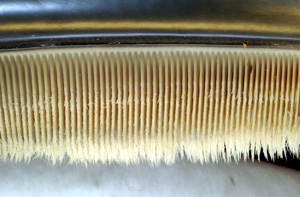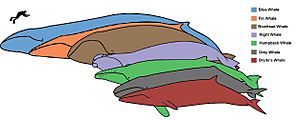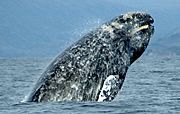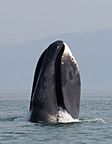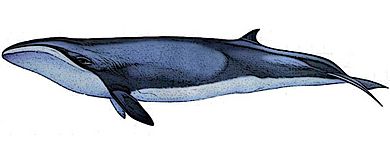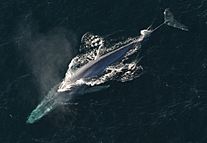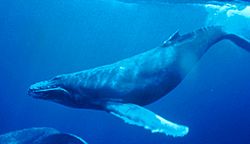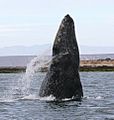Baleen whales facts for kids
Quick facts for kids Baleen whalesTemporal range: latest Eocene - Recent
|
|
|---|---|
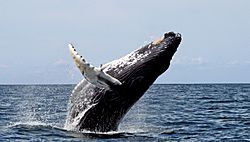 |
|
| Humpback whale breaching | |
| Scientific classification | |
| Kingdom: | |
| Class: | |
| Order: | |
| Suborder: |
Mysticeti
Cope, 1891
|
| Families | |
|
Balaenidae |
|
Baleen whales are amazing ocean giants! They are a group of whales called Mysticeti. You might also hear them called 'whalebone whales' or 'great whales'. Unlike toothed whales, baleen whales have special plates called baleen in their mouths. These plates help them filter tiny food from the water.
There are four main families of baleen whales, with fourteen different species.
Contents
What is Baleen?
Baleen whales do not have regular teeth like humans or other animals. Instead, they have baleen plates. These plates look like a giant curtain hanging down from the top of the whale's mouth. Some plates can be as long as 12 feet!
From the outside, baleen looks like straight blades. But on the inside, it's like a huge toothbrush or comb. Baleen is made of keratin. This is the same material found in your hair and fingernails!
How Do Baleen Whales Eat?
Baleen whales use their baleen to catch their food. First, a whale opens its mouth very wide. It scoops up huge amounts of water, along with tiny creatures like plankton, krill, small fish, and even copepods.
Then, the whale partly closes its mouth. It presses its tongue against its upper jaw. This pushes the water out through the baleen plates. The baleen acts like a giant filter, trapping all the small prey inside. The whale then swallows its meal.
Different Kinds of Baleen Whales
Baleen whales come in many shapes and sizes. Their bodies are often shaped by how they find food.
Rorqual Whales
Rorquals are a type of baleen whale. They have special pleats or grooves on their throats. These pleats stretch out like an accordion. This allows them to open their mouths super wide to scoop up lots of water and food.
Rorquals often use a feeding method called "lunge-feeding." They swim very fast into a group of small fish, called a bait ball. This speed helps them build up water pressure to expand their mouths. Rorquals usually have sleek, streamlined bodies. This helps them move quickly through the water.
Right Whales
Right whales are another type of baleen whale. They don't have throat pleats like rorquals. Instead, they have very large heads. This big head helps them feed effectively. Right whales tend to be very large and bulky. They don't need a streamlined body because of their feeding style. They also have rough patches on their heads called callosities.
Right whales have a lot of blubber, which is a thick layer of fat. This makes them float easily in the water. Rorquals, on the other hand, have more muscle and tend to sink.
Gray Whales
Gray whales are easy to spot! They are a sleet-gray color. They also have bumps, like knuckles, on their backs instead of a smooth fin. You might also see gray-white scars on them from parasites.
Like rorquals, gray whales have throat pleats. These pleats help them filter large amounts of water. Gray whales are "bottom-feeders." This means they sift through sand on the ocean floor to find food. They often turn on their sides to scoop up mud and filter out small creatures like amphipods. This can leave noticeable marks on their heads.
Pygmy Right Whales
The pygmy right whale is quite small for a baleen whale. It can sometimes be mistaken for minke whales. They both have dark gray tops, light gray bottoms, and light patches around their eyes.
Why Do Whales Jump?
Even though they are incredibly heavy, baleen whales can jump completely out of the water! This amazing act is called "breaching." Humpback whales are especially famous for their jumps. Other baleen whales also jump or loudly slap the water with their fins.
Scientists aren't completely sure why whales breach. It might be a way for them to communicate with each other. It could also be for fun, to remove parasites, or to show off their strength.
How Baleen Whales Evolved
The oldest real fossils of baleen are about 15 million years old. However, baleen doesn't fossilize easily. Scientists think baleen whales appeared much earlier than that. DNA evidence also supports this idea.
Scientists believe baleen might have started to evolve around 30 million years ago. It might have developed from a hard, gummy upper jaw. Some early baleen whales even had teeth. But these teeth were probably not used much, or perhaps not at all for eating.
Whales and Humans
For many centuries, from the 1100s to the late 1900s, baleen whales were hunted by humans. They were hunted for their oil and their baleen. Whale oil was used to make things like margarine and cooking oils. Baleen was used to stiffen corsets, as ribs for parasols, and even to crease paper. Today, hunting whales is mostly banned or strictly controlled.
Images for kids
-
Restoration of Janjucetus hunderi
-
Early baleen whales, like Janjucetus, had teeth.
-
Megalodon was a giant shark that hunted ancient baleen whales.
-
Humpback whales working together to lunge-feed using bubble net fishing.
See also
 In Spanish: Mysticeti para niños
In Spanish: Mysticeti para niños


